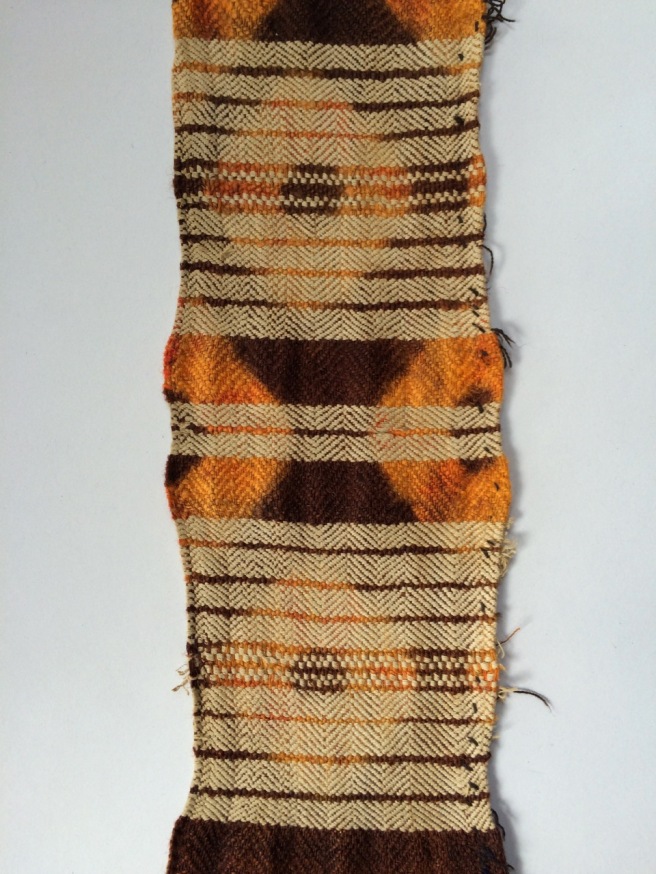Cross dyeing: A method of coloring fabrics made from more than one kind of fiber. Each fiber in a fabric designed for cross–dyeing takes a specific dye in a different color or in variations of a color.
… The Fabric Dictionary
As a weaver, I often construct my own textiles before they are dyed. I choose warp yarns, weft yarns, and then make decisions about how they are going to be fit together. When a fabric is constructed using both protein and cellulose fibers, some dyes can be made to attach only to the wool. Direct dyes, such as black walnut husks, are a great example. When used on wool or silk, without the use of a mordant, those fibers will dye a deep brown, while any cotton used in the construction of the textile will only be lightly stained or absorb no dye at all.
This allows me to weave fabrics in white or natural, and then apply the color afterwards, using resists to incorporate design and create layers of color.

When indigo in used in combination with a direct dye, the cotton will only absorb the indigo blue. The protein fiber will absorb some of the indigo, but it is initially a much lighter blue. When overdyed with a direct dye, only the protein fibers will accept that direct dye.
This is an approach I have taken to dyeing my woven textiles for a number of years, ever since I was inspired by a Moroccan belt fabric that used acid dyes to achieve the effects of cross dyeing.

When I began working with natural dyes and wanted to do cross dyeing, I was initially limited to the use of direct dyes, such as black walnut husks, lichens or other dyes that did not require a mordant. If a mordant is used, both fibers will dye to some extent. Then Michel Garcia introduced me to the concept of one-bath dyeing. This is where tannins and acid are used to attach some dyes to a protein, while the cellulose fibers do not dye at all. In effect, the dyes behave like acid dyes. No mordant is required when applying dyes with this process.
But not everyone is a weaver! Next month I will be teaching natural dyeing for knitters at the first Knitting Getaway at Shakerag Workshops . In preparation, I have been knitting samples that incorporate both wool and cotton. I have added resists, and dyed with combinations of indigo and one-bath acid dyes. This concept can also be applied to knitting yarns that incorporate both wool and cotton.
It is challenging to identify commercially available fabrics for cross dyeing. I have had fabrics specially woven of wool and cotton for the class that I’ll be teaching at the 11th International Shibori Symposium in Nagoya, Japan. Space is still available in the workshop right now!


And on another exciting note: The Art and Science of Natural Dye will be published by Schiffer Publishers in the fall and is now available for pre-order from Schiffer or Amazon. In fact, I just finished the last of the copy edits today!











Congrats Catherine and Joy! I can’t wait to get my copy 💙
Thanks Fayette!
Looking forward to the publication of THE ART AND SCIENCE OF NATURAL DYEING. Attended Penland August 2017 to study Katazome & Natural Dye Techniques with Akemi Nakano Cohn. Apply Shibori and Katazome techniques and indigo dye to silk squares 22″ x 22.” Not a weaver at this time.
There is always so much to learn. I’ve been wanting to take a class with Akemi for a long time….
Congratulations on your book!
Can’t wait to get the book! I was in your workshop in Minneapolis this spring. We are so fortunate that you and Joy are sharing this knowledge and technique.
thanks, Sue!
Thanks for such an interesting post, lots to think about and experiment. I’m just wondering where I could find more information about Michel Garcia’s method, in one of his books or the dvds? Or perhaps you will cover this in your new book (which will definitely be on my Christmas list!) ? Thank you
Michel does cover the one-bath method of dyeing in the 2nd DVD, Colors of the Americas. I know that it will also be included in the the new DVD that was just filmed – and likely out in the fall. And YES, it is included in the book!
YES! Just pre-ordered the book, and SO looking forward to it! Very tired of all the “experts” with self published books on how to dye with beets, mulberries spinach/grass/dandilionrootsthatgive magenta so you can consider yourself a Natural Dyeing Master…….
THANK YOU!!!!!!!!!!!!